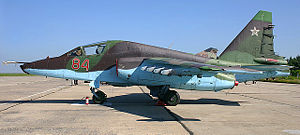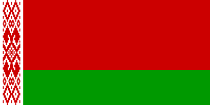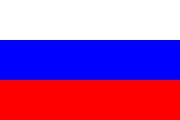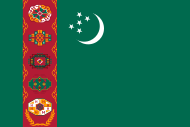Sukhoi Su-25
| Su-25 | |
|---|---|
 |
|
| Russian Air Force Su-25T | |
| Role | Close air support[1] aircraft |
| Manufacturer | Sukhoi Design Bureau |
| First flight | 22 February 1975 (T8) |
| Introduced | 1981 |
| Status | Active service |
| Primary users | Soviet Air Force Russian Air Force Ukrainian Air Force Peruvian Air Force |
| Number built | 1,024 |
| Unit cost | US$11 million[1] |
| Variants | Sukhoi Su-28 |
The Sukhoi Su-25 is a single-seat, twin-engine jet aircraft developed in the Soviet Union by the Sukhoi Design Bureau. It was designed to provide close air support for the Soviet Ground Forces. The first prototype made its maiden flight on 22 February 1975. After testing, the aircraft went into series production in 1978 at Tbilisi in the Soviet Republic of Georgia. NATO assigned the new aircraft the reporting name "Frogfoot".
Early variants included the Su-25UB two-seat trainer, the Su-25BM for target-towing, and the Su-25K for export customers. Upgraded variants developed by Sukhoi include the Su-25T and the further improved Su-25TM (also known as Su-39). By year 2007, the Su-25 is the only armoured airplane still in production except the Su-34 whose production just started.[1] It is currently in service with Russia and various other CIS states as well as export customers.
During its more than twenty-five years in service, the Su-25 has seen combat with several air forces. It was heavily involved in the Soviet war in Afghanistan, flying counter-insurgency missions against the Mujahideen. The Iraqi Air Force employed Su-25s against Iran during the 1980–89 Iran–Iraq War. Most of them were later destroyed or fled to Iran in the 1991 Gulf War. In 1993, Abkhazian separatists used Su-25s against Georgians during Abkhazian War.[2] Eight years later, the Macedonian Air Force employed Su-25s against Albanian insurgents in the 2001 Macedonia conflict, and in 2008 Georgia and Russia were both reported to be using Su-25s in the 2008 South Ossetia War.[3]
Contents |
Development
In early 1968, the Soviet Ministry of Defence decided to develop a specialised shturmovik armoured assault aircraft in order to provide close air support for the Soviet Ground Forces. The idea of creating a ground-support aircraft came about after analysing the experience of shturmovaya (attack) aviation during World War II, and in local wars during the 1950s and 1960s.[4] The Soviet fighter-bombers in service or under development at this time (Su-7, Su-17, MiG-21 and MiG-23) did not meet the requirements for close air support of the army.[4] They lacked essential armour plating to protect the pilot and vital equipment from ground fire and missile hits, and their high flight speeds made it difficult for the pilot to maintain visual contact with a target. Having taken into account these problems, Pavel Sukhoi and a group of leading specialists in the Sukhoi Design Bureau started preliminary design work in a comparatively short period of time, with the assistance of leading institutes of the Ministry of the Aviation Industry and the Ministry of Defence.[5]

In March 1969, a competition was announced by the Soviet Air Force that called for designs for a new battlefield close-support aircraft. Participants in the competition were the Sukhoi Design Bureau and the Design Bureaux of Yakovlev, Ilyushin and Mikoyan.[6] Sukhoi finalised its "T-8" design in late 1968, and began in work on the first two prototypes (T8-1 and T8-2) in January 1972. The T8-1, the first airframe to be assembled, was completed just before a major national holiday on 9 May 1974. However, it did not make its first flight until 22 February 1975, after a long series of test flights by Vladimir Ilyushin. The Su-25 surpassed its main competitor in the Soviet Air Force competition, the Ilyushin Il-102, and series production was announced by the Ministry of Defence.[7]
During flight-testing phases of the T8-1 and T8-2 prototypes' development, the Sukhoi Design Bureau's management proposed that the series production of the Su-25 should start at Factory No. 31 in Tbilisi, Soviet Republic of Georgia, which at that time was the major manufacturing base for the MiG-21UM "Mongol-B" trainer. After negotiations and completion of all stages of the state trials, the Soviet Ministry of Aircraft Production authorised manufacture of the Su-25 at Tbilisi, allowing series production to start in 1978.[8]
In the late 1980s and early 1990s, several Su-25 variants appeared, including modernised versions, and variants for specialised roles. The most significant designs were the Su-25UB dual-seat trainer, the Su-25BM target-towing variant, and the Su-25T for antitank missions. In addition, an Su-25KM prototype was developed by Georgia in co-operation with Israeli company Elbit Systems in 2001, but so far this variant has not achieved much commercial success. The Su-25 is the only armoured airplane still in production in 2007.[1]
The Russian Air Force operates the largest number of Su-25s, and has plans to upgrade older aircraft to the Su-25SM variant. However, this process has been slowed due to a funding shortfall, by early 2007 only seven aircraft had been modified.[9]
Design

The Su-25 has a normal aerodynamic layout with a shoulder-mounted trapezoidal wing and a conventional tailplane and rudder. Several different metals in differing amounts are used in the construction of the airframe: 60% aluminium, 19% steel, 13.5% titanium, 2% magnesium alloy, and 5.5% other materials.[10]
Cockpit
The pilot flies the aircraft by means of a centre stick and left hand throttles. The pilot sits on a Zvezda K-36 ejection seat (similar to the Sukhoi Su-27), and has standard flight instruments. At the rear of the cockpit is a 6 mm (0.24 in) thick steel headrest, mounted on the rear bulkhead. The cockpit has a bathtub-shaped armoured enclosure of welded titanium sheets, with transit ports located in the walls. Guide rails for the ejection seat are mounted on the rear wall of the cockpit.[10]
The canopy hinges open to the right, and the pilot enters using the flip-down ladder. Once inside, the pilot sits low in the cockpit, protected by the bathtub assembly which makes for a cramped cockpit. Visibility from the cockpit is limited, being a trade-off for improved pilot protection. Rearwards visibility is very limited, though a periscope is fitted on top of the canopy to compensate. The cockpit control layout is old-fashioned, lacking even a Head-Up Display (HUD).[11]
The cannon is located in a compartment beneath the cockpit, mounted on a load-bearing beam attached to the cockpit floor and the forward fuselage support structure. An airtight avionics compartment is behind the cockpit and in front of the forward fuel tank. On the left-hand rear side of the cockpit, a built-in ladder provides access to the cockpit, the upper part of the engine nacelles, and the wing. The nose is fitted with distinctive twin pitot probes and hinges up for service access.[10]
Wings and fuselage

All versions of the Su-25 have a metal cantilever wing, of moderate sweep and high aspect ratio, and equipped with high-lift devices. The wing consists of two cantilever sections attached to a central torsion box, forming a single unit with the fuselage. The air brakes are housed in separate fairings at the tip of each wing. Each wing has five hardpoints for weapons carriage, with the attachment points mounted on load-bearing ribs and spars.[12] Each wing also features a five-section leading-edge slat, a two-section flap, and an aileron.
The flaps are mounted by steel sliders and rollers, attached to brackets on the rear spar. The trapezoidal ailerons are located near the wingtips.[13] The fuselage of the Su-25 has an ellipsoidal section and is of semi-monocoque, stressed-skin construction, arranged as a longitudinal load-bearing framework of longerons, beams and stringers, with a transverse load-bearing assembly of frames.[10] The one-piece horizontal tailplane is attached to the load-bearing frame at two mounting points.[13]
Powerplant
Early versions of the Su-25 were equipped with two R95Sh non-afterburning turbojets, in separate compartments on either side of the rear fuselage. The engines, sub-assemblies, and surrounding fuselage structure are cooled by air provided by the cold air intakes located on top of the engine's nacelles. A drainage system collects oil, hydraulic fluid residues, and fuel from the engines after flight or after an unsuccessful start. The engine control systems allows independent operation of each engine.[13] The latest versions (Su-25T and TM) are equipped with improved R-195 engines.[14]
Avionics
The avionics system of the Su-25 consists of several components:[15]
- Weapons-aiming system, providing targeting data for ground munitions, as well as the targeting of aircraft in VMC: the Klen-PS laser rangefinder utilises a glass porthole in the aircraft's nose and is perhaps the most notable item of avionics. It provides a laser target designation capability whereby the pilot locks the designator onto a target through his gun-sight allowing launch of a laser-guided missile and using the Klen-PS to guide it. Dropping a laser-guided bomb would be more difficult, however, given the porthole’s forward view. This suggests that Su-25s would use "buddy designation" i.e. one aircraft standing off a safe distance to illuminate a target while the other attacked it.[11]
- A DISS-7 Doppler radar
- Navigation system, permitting flight in day and night conditions, both in VMC and IMC, and providing flight data for the weapons-control system and flight instruments
- Radios for air-to-ground and air-to-air communications
- Weapons-control system
- Self-defence suite, incorporating infra-red, flare and chaff dispensers capable of launching about 250 flares and dipole chaff, and an SRO radar warning receiver that can alert the pilot of incoming attacks on the aircraft
- An SPO-15 radar homing & warning system (RHAWS)
- An SO-69 identification-friend-or-foe (IFF) transponder
Operational history
Soviet war in Afghanistan
On 19 July 1981, the 200th Independent Shturmovaya Air Squadron was assigned to Shindand Airbase in western Afghanistan, becoming the first Su-25 unit deployed to that country. Its main task was to conduct air strikes against mountain military positions and structures controlled by the Afghan rebels.[16]
Over the course of the Soviet war in Afghanistan, Su-25s launched a total of 139 guided missiles of all types against Mujahideen positions. On average, each aircraft performed 360 sorties a year, a total considerably higher than that of any other combat aircraft in Afghanistan. By the end of the war, nearly 50 Su-25s were deployed at Afghan airbases, carrying out a total of 60,000 sorties. Between the first deployment in 1981 and the end of the war in 1989, 21 aircraft were lost in combat operations.[16]
Iran–Iraq War

The Su-25 also saw combat during the Iran–Iraq War of 1980–1988. The first Su-25s were commissioned by the Iraqi Air Force in 1987 and performed approximately 900 combat sorties throughout the course of the war, carrying out the bulk of Iraqi air attack missions. During the most intense combat of the war, Iraqi Su-25s were performing up to fifteen sorties per day each. In one recorded incident, an Iraqi Su-25 was shot down by an Iranian Hawk surface to air missile, but the pilot managed to eject. This was the only confirmed successful Iranian attack against an Iraqi Su-25. After the war, Saddam Hussein decorated all of the Iraqi Air Force's Su-25 pilots with the country's highest military decoration.[16]
Gulf War
During the Gulf War (Operation Desert Storm), the air superiority of the coalition forces was so great that the majority of Iraqi Su-25s did not even manage to get airborne. On 25 January 1991, seven Iraqi Air Force Su-25s fled from Iraq and landed in Iran.[17]
On the evening of 6 February 1991, two US Air Force F-15C Eagle fighters of the 53rd Tactical Fighter Squadron, operating out of Al Kharj Air Base in Saudi Arabia, intercepted a pair of Iraqi MiG-21s and a pair of Su-25s. All four Iraqi aircraft were shot down, with both Su-25s coming down in the desert not far from the Iraqi border with Iran. This was the Iraqi Su-25's only air combat of the war.[16]
Ethiopian-Eritrean War
The Su-25 was used by the Ethiopian Air Force. On May 15, 2000 An Ethiopian Su-25 attack plane was shot down by an Eritrean MiG-29, killing the pilot.[18]
2001 Macedonian conflict
Su-25s were used by the Macedonian Air Force during the 2001 Macedonia conflict against Albanian separatists. Beginning on 24 June 2001, the aircraft made multiple attack runs against separatist positions. The most successful operation took place on 10 August 2001, in the village of Raduša, when SU-25s attacked Albanian militants who had ambushed and killed sixteen Macedonian soldiers over the previous two days.[19]
Ivorian-French War
On 6 November 2004, at least one Ivorian Sukhoi Su-25 attacked a position of France's Unicorn peacekeeping force in the rebel stronghold of Bouake at 1300 hours local time, causing nine deaths and 37 wounded among the French soldiers. Shortly afterwards, the French military retaliated by attacking the Yamoussoukro airport with Gazelle gunship helicopters, destroying the only two Sukhoi Su-25 planes the Ivorian air force had by firing 20mm shells at them.[20] [21]
2008 Georgia-Russia War
In August 2008, an unknown number of Su-25s of the Georgian Air Force participated in bombing raids on targets in South Ossetia during the War in South Ossetia,[3] and Russian military Su-25 undertook air raids on targets in Georgia.[22] The Russian military officially confirmed the loss of three Su-25 aircraft to the Georgian air defense.[23][24] In early August 2008, Russian Su-25s attacked the Tbilisi aircraft plant, where Su-25 is produced, dropping bombs on the factory's airfield.[25]
Variants
Su-25



The basic version of the aircraft was produced at Factory 31, at Tbilisi, in the Soviet Republic of Georgia. Between 1978 and 1989, 582 single-seat Su-25s were produced in Georgia, not including aircraft produced under the Su-25K export program. This variant of the aircraft represents the backbone of the Russian Air Force's Su-25 fleet, currently the largest in the world.[8]
The aircraft experienced a number of accidents in operational service caused by system failures attributed to salvo firing of weapons. In the wake of these incidents, use of its main armament, the 240 mm S-24 missile, was prohibited. In its place, the FAB-500 500 kg general-purpose high-explosive bomb became the primary armament.[8]
Su-25K
The basic Su-25 model was used as the basis for a commercial export variant, known as the Su-25K (Komercheskiy). This model was also built at Factory 31 in Tbilisi. The aircraft differed from the Soviet Air Force version in certain minor details concerning internal equipment. A total of 180 Su-25K aircraft were built between 1984 and 1989.[8]
Su-25UB
The Su-25UB trainer (Uchebno-Boyevoy) was drawn up in 1977. The first prototype, called "T-8UB-1", was rolled out in July 1985 and its maiden flight was carried out at the Ulan-Ude factory airfield on 12 August of that year.[8] It was intended for training and evaluation flights of active-duty pilots, and for training pilot cadets at Soviet Air Force flying schools.
The performance of the Su-25UB did not differ substantially from that of the single-seater. The navigation, attack, sighting devices and weapons-control systems of the two-seater enabled it to be used for both routine training and weapons-training missions.[26] By the end of 1986, a total of 25 Su-25UBs had been produced at Ulan-Ude, despite the fact that the twin-seater had not yet completed its State trials and therefore had not been officially cleared for service with the Soviet Air Force.[27]
Su-25UBK
From 1986 to 1989, in parallel with the construction of the main Su-25UB combat training variant, the Ulan-Ude plant produced the so-called "commercial" Su-25UBK, intended for export to countries that bought the Su-25K, and with similar modifications to that aircraft.[28]
Su-25UTG
The Su-25UTG (Uchebno-Trenirovochnyy s Gakom) is a variant of the Su-25UB designed to train pilots in takeoff and landing on a land-based simulated carrier deck, with a sloping ski-jump section and arrester wires. The first one flew in September 1988, and approximately ten were produced.[29] About half remained in Russian service after 1991, used with Russia's sole aircraft carrier, the Admiral Kuznetsov. Such a small number of aircraft were insufficient to serve the training needs of Russia's carrier air group, so a number of Su-25UBs were converted into Su-25UTGs, these aircraft being distinguished by the alternative designation Su-25UBP (Uchebno-Boyevoy Palubny) —the adjective "palubnyy" meaning "deck", indicating that these aircraft have a naval function.[30] About ten of these aircraft are currently operational in the Russian Navy as part of the 279th Naval Aviation Regiment.[31]
Su-25BM
The Su-25BM (Buksirovshchik Misheney) is a target-towing variant of the Su-25 whose development began in 1986. The prototype, designated "T-8BM1", successfully flew for the first time on 22 March 1990, at Tbilisi, and the aircraft was put into production after completion of the test phase.[30]
The Su-25BM target-tower was designed to provide towed target facilities for training ground forces and naval personnel in ground-to-air or naval surface-to-air missile systems. It is powered by an R-195 engine and equipped with an RSDN-10 long-range navigation system, an analogue of the Western LORAN system.[30]
Su-25T

The Su-25T (Tankovy) is a dedicated antitank version, which has been battle tested with notable success in combat missions over Chechnya.[32] Avionics have been modified, including sophisticated autopilot and HUD installed. It is equipped with "Shkval" TV observation and aiming system with laser rangefinder and target designator in the nose cone (the same is used on the Ka-50 attack helicopter) and may carry "Vikhr" laser beam riding AT missiles in 8-tube launchers (Ka-50 carries the same missiles in 6-tube launchers). The efficiency of this weapon system on a jet plane is disputed, as it is not a "fire-and-forget" weapon, and while a hovering helicopter may illuminate a target with a laser while staying at maximum range, a Su-25T flying towards its target until the "Vikhr" impact may eventually enter the range of close air defences. The night vision capabilities of "Shkval" are limited. For night operations a container with low-light TV "Merkuriy" system may be carried under the fuselage (having only 5x magnification in comparison with 23x of the "Shkval"). Alternatively, the "Fantasmagoria" passive radar sensor container may be carried, which provides targeting data for anti-radiation missiles, giving the Su-25T an air defence suppression capability. The Su-25T can also employ the KAB-500Kr TV-guided bomb and Kh-29T TV-guided heavy tactical air-to-ground missile.[32]
A second-generation Su-25T, the Su-25TM (also designated Su-39), has been developed with improved navigation and attack systems, and better survivability. While retaining the built-in "Shkval" of Su-25T, it may carry "Kopyo" (rus. "Spear") radar in the container under fuselage, which is used for engaging air targets (with RVV-AE/R-77 missiles) as well as ships (with Kh-31 and Kh-35 antiship missiles). The Russian Air Force has received only a small number of each version so far. However, the improved avionics systems designed for these aircraft have been utilised in the Su-25SM, an interim upgrade for the series-produced Russian Air Force Su-25, resulting in superior survivability and combat capability.[32]
Su-25KM

The SU-25KM (Kommercheskiy Modernizirovannyy), nicknamed "Scorpion", is an Su-25 upgrade programme announced in early 2001 by the original manufacturer, Tbilisi Aerospace Manufacturing in Georgia, in partnership with Elbit Systems of Israel. The prototype aircraft made its maiden flight on 18 April 2001 at Tbilisi in full Georgian Air Force markings.[33]
The aircraft uses a standard Su-25 airframe, enhanced with advanced avionics including a glass cockpit, digital map generator, helmet-mounted display, computerised weapons system, complete mission pre-plan capability, and fully redundant backup modes. Performance enhancements include a highly accurate navigation system, pinpoint weapon delivery systems, all-weather and day/night performance, NATO compatibility, state-of-the art safety and survivability features, and advanced onboard debriefing capabilities complying with international requirements.[33]
Su-28
The Sukhoi Su-28 (also designated as Su-25UT - Uchebno-Trenirovochnyy) is an advanced basic jet trainer, built on the basis of the Su-25UB as a private initiative by the Sukhoi Design Bureau. The Su-28 is a light aircraft designed to replace the Czechoslovak Aero L-39 Albatros. Unlike the basic Su-25UB, it lacks a weapons-control system, built-in cannon, weapons hardpoints, and engine armour.[34]
Other
- Su-25R (Razvedchik) – a tactical reconnaissance variant designed in 1978, but never built.[35]
- Su-25U3 (Uchebnyy 3-myestny) – also known as the "Russian Troika", was a three-seat basic trainer aircraft. The project was suspended in 1991 due to lack of funding.[35]
- Su-25U (Uchebnyy) – a trainer variant of Su-25s produced in Georgia between 1996 and 1998. Three aircraft were built in total, all for the Georgian Air Force.[35]
Operators



 Afghanistan
Afghanistan- Between 1986 and 1990, a number of Su-25s were reportedly handed over by the Soviet Union to the Afghan government. Depending on the source consulted, the number of Afghan Su-25s varies between twelve and sixty aircraft. The actual number of Afghan Su-25s has never been established, nor has it been verified whether any remain in the Afghan Air Force service. Since no evidence of Afghan operation of the Su-25 has emerged during recent allied operations, it is likely the "Frogfoot" was never actually acquired by the country.[36]
 Angola
Angola- An agreement was reached at the beginning of 1988 between the Soviet Union and Angola that arranged for the delivery of a squadron of Su-25s. The Angolan export agreement comprised 12 single-seat Su-25Ks and two Su-25UBKs trainers. Later, these aircraft were augmented by further deliveries comprising at least three two-seater aircraft.[36]
 Armenia
Armenia- Following the break-up of the Soviet Union, Armenia had no Su-25s in its inventory, but following the start of the conflict in Nagorno-Karabakh in 1991–92, the newly independent Republic of Armenia unofficially acquired a small number of aircraft (11 single-seaters and four Su-25UBs).[36][37]
 Azerbaijan
Azerbaijan- Like Armenia, Azerbaijan did not inherit any Su-25s after the collapse of the USSR, but a single aircraft was obtained in April 1992 as a consequence of a pilot defecting from the Russian Air Force base at Sital-Chai. Following the incident, Azerbaijan acquired at least five Su-25s through unofficial channels, and one more aircraft has been obtained as the result of yet another defection, this time from the Georgian Air Force. Other aircraft are believed to have been acquired later, as a 2001 inventory of Azerbaijan aircraft revealed that the Azerbaijan Air Force still had three of the type in its inventory, despite the reported loss of four Su-25s in combat operations relating to Nagorno-Karabakh against Armenia.[36]
 Belarus
Belarus- After the break-up of the Soviet Union, Belarus was the second member state of the CIS, after Russia, to have a significant number of Su-25s. Seventy Su-25s and six Su-25UBs are reported to be operational and are mostly concentrated at Lida air base by year 2004.[38]
 Bulgaria
Bulgaria- Bulgaria was the second Warsaw Pact country to obtain the Su-25, acquiring its first examples of both Su-25K and the Su-25UBK in 1985. The aircraft were intended to replace the obsolete MiG-17F Fresco-C which had been the backbone of the Bulgarian Air Force fighter-bomber fleet for many years. Twenty Su-25Ks and three Su-25UBKs were commissioned and are operational at Bezmer air base by year 2004.[38]
 Democratic Republic of the Congo
Democratic Republic of the Congo- In late 1999, the Tbilisi Aerospace Manufacturing plant signed a contract with the Democratic Republic of Congo for the delivery of 10 Su-25Ks to the Force Aerienne Congolaise. The deal was reported to be valued at 6 million US Dollars, and the first four aircraft were delivered on board an An-124 in November 1999. The remaining six aircraft were delivered in January 2000.[38] One aircraft crashed in December 2006 during a routine flight, while another one crashed on 30 June 2007, during a Congolese independence day display.[39]
 Ethiopia
Ethiopia- A pair of Su-25Ts and two Su-25UBK combat trainers were delivered to Ethiopia in the first quarter of 2000. The twin-seaters were withdrawn from Russian Air Force service and modified in accordance to a special request by the Ethiopian Air Force. Since acquiring the aircraft, the Ethiopians have used them in combat operations against Eritrean insurgent groups.[38]
 Georgia
Georgia- Georgia, which produced hundreds of MiG-21U/UM/US "Mongol" trainers and scores of single-seat Su-25s during the Soviet era, was left with virtually no aircraft following the break-up of the Soviet Union. Only a small number of single-seat Su-25s were actually taken on to the inventory of the newly formed Georgian Air Force, these aircraft having been left in the factory at the time of Georgian independence. Georgia had nine Su-25s of various types with of them eight Su-25KM "Scorpion"s (an upgraded version of the Su-25 in collaboration with Israel) as of 2004.[40]
 Iran
Iran- On 21 January 1991, seven Iraqi Air Force Su-25s were flown to Iran in an effort to find a temporary safe haven from Operation Desert Storm attacks on major Iraqi airfields. These Iraqi aircraft were considered by the Iranians to be a gift from their former adversary, and were seized by the Iranian military. However, as a result of lack of spare parts, documentation, and pilot training, these aircraft were never flown by the Iranian Air Force. Iran's Islamic Revolutionary Guards Corps Air Force has added at least six new aircraft to its inventory and has since likely restored ex-Iraqi Su-25s to flight status as well.[17]
 Kazakhstan
Kazakhstan- The Kazakh Air Force received 12 single-seat Su-25s and two Su-25UB trainers in December 1995 as compensatory payment for the return of the Tu-95MS "Bear-H" strategic bombers which had been rapidly flown out of the republic at the time of the collapse of the USSR. The Kazakh Su-25s are located at Chimkent air base in the south of the country.[38]
 North Korea
North Korea- North Korea was the first Asian country to obtain the Su-25. In the 1950s, the North Korean Air Force had accumulated useful experience of operating the Su-25's piston-engined predecessor, the Ilyushin Il-10 "Beast". In the period from the end of 1987 until 1989, the DPRK acquired a total of thirty-two single-seat Su-25Ks and four Su-25UBKs. The aircraft are based at Sonchon air base (80 km from Pyongyang), which features heavily-fortified natural hangars equipped with blast-proof doors capable of protecting the aircraft from conventional and nuclear explosions.[19]

 Peru
Peru- Peru received eighteen Su-25s in late 1998 from Belarus, which refurbished them prior to delivery. The shipment comprised 10 single-seat and eight dual-seat Su-25UB trainers. The aircraft were all built just before the collapse of the Soviet Union and thus represented the final versions of the Soviet Su-25. It is believed that between 1998 and December 2005, at least 25 light aircraft transporting cocaine had been shot down by the Peruvian Su-25s.[19]
 Russia
Russia- Today, Russia possesses a reduced fleet of Su-25s, which are operated by "Shturmovoi" Assault Regiments. The major variants used are the single-seat Su-25, the twin-seat Su-25UB, and the Su-25BM target-towing version. In addition, the Russian Air Force received a small number of Su-25T anti-tank variants, which have been tested with notable success under combat conditions in Chechnya. The Su-25 is also operated by the Russian Navy, both in standard land-based Su-25 and Su-25UB guise, as well as in the specialised Su-25UTG role as a carrier-operable trainer. Overall, 245 Su-25s are in service with the Russian Air Force, including 10 being operated by the navy as of 2008.[31] A modernisation program of single-seat Su-25s to the Su-25SM variant is underway.[19] The first modernised Su-25SM was delivered in August 2001, while another six were delivered in late December 2006 at Lipetsk air base.[9]
 Turkmenistan
Turkmenistan- Following the downfall of the Soviet Union, the newly independent Republic of Turkmenistan was given 46 Su-25s which had been disassembled for storage in Turkmenistan at that time. In accordance with an agreement between Georgia and Turkmenistan in 1999, the Tbilisi Aerospace Manufacturing corporation refurbished 45 of these aircraft for use by the Turkmenistan Air Force as payment for the delivery of natural gas. The refurbished aircraft were relocated at Ak-Tepe air base, and a total of 18 operational Su-25s are known to be based there by year 2004.[19]

 Ukraine
Ukraine- Ukraine obtained 92 Su-25s of differing variants following the country's independence in the wake of the break-up of the USSR. Currently, the Ukrainian Air Force operates approximately 60 Su-25, Su25UBs, and Su-25UTGs, which are operated by the 299th Independent Assault Regiment (299 OShAP) based at Kulbakino, Mykolaiv Oblast, and at Saki in the Crimea, and the 456th Assault Regiment (456 ShAP) at Chortkiv. Up to 30 Su-25s are reportedly stored at the 4070th Reserve Base. Evidently, three Su-25s sold to Macedonia came from this reserve pool.[19]
 Uzbekistan
Uzbekistan- Until 1990, a Soviet Air Force pilot training centre equipped with around 20 Su-25, Su-25UB, and Su-25BM variants was located at Chirchik air base in Uzbekistan. In 1991, a small number of Su-25s were also located at Dzhizak air base, but after 1991, all Su-25s in Uzbekistan were concentrated at Chirchik, operated by the 59th Fighter-Bomber Aviation Regiment (59 APIB) of the Soviet Air Force. After the collapse of the Soviet Union, all the Su-25s on the territory of the now independent republic became the property of the new government.[19]
Former operators

 Côte d'Ivoire (Ivory Coast)
Côte d'Ivoire (Ivory Coast)- Nine French soldiers were killed and twenty-three wounded when two Ivorian Su-25s bombed French positions in Bouaké.[41] As a result, French soldiers destroyed the Su-25s on the ground at Yamoussoukro air base.[42]
 Czechoslovakia
Czechoslovakia- Passed aircraft onto successor states, in the ratio of 2:1 in favour of the Czech Republic.[38]
 Czech Republic
Czech Republic- After the dissolution of Czechoslovakia, the Czech Republic acquired twenty-four Su-25Ks and one Su-25UBK. In December 2000, the Czech Su-25s were retired from service and placed in storage at Přerov air base.[43]
 Macedonia
Macedonia- The Republic of Macedonia purchased three single-seat Su-25s and one Su-25UB following incursions and attacks by Albanian separatists. The aircraft were supplied by Ukrainian authorities after having been withdrawn from Ukrainian Air Force service.[44] The aircraft were retired in 2004 and later sold to Georgia in 2005.[45]
 Iraq
Iraq- During the course of the early phase of the Iran–Iraq War, Iraq approached the Soviet Union with a request to purchase a wide variety of military equipment. As a result, Iraq become the first non-Warsaw Pact country to obtain the Su-25K and Su-25UBK combat trainer. It is believed that Iraq received a total of 73 Su-25s, of which four were the Su-25UBK trainer. In January 1998, the Iraqi Air Force still possessed 12 Su-25s, and at least three Su-25Ks were seen in a demonstration over Baghdad in December 2002. However, the remaining Su-25s were phased out immediately after the 2003 Invasion of Iraq.[38]
 Slovakia
Slovakia- The Slovak Air Force received 12 Su-25Ks and one Su-25UBK following the dissolution of Czechoslovakia. The aircraft were based at the Slovak 33rd Air Base in Malacky-Kuchyna. They were sold to Armenia.[38]
 Soviet Union
Soviet Union - Passed aircraft onto successor states.
Accidents and incidents
- An Air Force of the Democratic Republic of the Congo Su-25K disappeared in December 2006 during a routine rebasing operation and no wreckage was ever found.[39]
- Another Congolese Su-25K crashed on 30 June 2007 during an Independence Day display, near the city of Kisangani, killing the pilot. Investigations revealed that the aircraft crashed due to an engine failure.[39]
- A Su-25 of the Russian Air Force exploded in air on 20 March 2008 during a live firing exercise over the Primorsky Krai, 143 km (89 mi) from Vladivostok, killing the pilot. Further investigations revealed that the aircraft was downed by a missile accidentally launched by a wingman. After the accident, all Russian Su-25s were grounded until the investigation concluded.[46]
Specifications (Su-25TM)
Data from Sukhoi Su-25 Frogfoot[1]
General characteristics
- Crew: one pilot
- Length: 15.33 m (50 ft 11)
- Wingspan: 14.36 m (47 ft 1 in)
- Height: 4.80 m (15 ft 9 in)
- Wing area: 30.1 m² (324 ft²)
- Empty weight: 10,740 kg (23,677 lb)
- Loaded weight: 16,990 kg (37,456 lb)
- Max takeoff weight: 20,500 kg (45,194 lb)
- Powerplant: 2× Tumansky R-195 turbojets, 44.18 kN (9,480 lbf) each
Performance
- Maximum speed: 950 km/h (590 mph, Mach 0.82)
- Combat radius: 375 km (235 mi)
- Ferry range: 2,500 km (1,553 mi)
- Service ceiling 10,000 m (22,200 ft)
- Rate of climb: 58 m/s (11,400 ft/min)
- Wing loading: 584 kg/m² (119 lb/ft²)
- Thrust/weight: 0.51
Armament
- 1× GSh-30-2 30mm cannon with 250 rounds
- 11 hardpoints for up to 4,400 kg (9,700 lb) of disposable ordnance, including rails for two R-60 (AA-8 'Aphid') or other air-to-air missiles for self-defence and a wide variety of general-purpose bombs, cluster bombs, gun pods, rocket pods, laser-guided bombs, and air-to-surface missiles such as the Kh-25ML
See also
Comparable aircraft
- A-10 Thunderbolt II
- Northrop YA-9
- Ilyushin Il-102
References
Notes
- ↑ 1.0 1.1 1.2 1.3 1.4 Gordon and Dawes 2004
- ↑ "Siege of Sukhumi." Time Magazine, 4 October 1993.
- ↑ 3.0 3.1 "N. Ossetia president: Georgian planes bomb out humanitarian aid convoy for S. Ossetia." Interfax, 8 August 2008. Retrieved: 8 August 2008.
- ↑ 4.0 4.1 Gordon and Dawes 2004, p. 6-7.
- ↑ Gordon and Dawes 2004, p. 8.
- ↑ Gordon and Dawes 2004, p. 11.
- ↑ Gordon and Dawes 2004, pp. 23–41.
- ↑ 8.0 8.1 8.2 8.3 8.4 Gordon and Dawes 2004, pp. 42–46.
- ↑ 9.0 9.1 "Force report: Russian Air Force." Air Forces Monthly, July 2007, pp. 78–86.
- ↑ 10.0 10.1 10.2 10.3 Gordon and Dawes 2004, pp. 73–75.
- ↑ 11.0 11.1 Goebel, Greg. The Sukhoi Su-25 "Frogfoot." vectorsite.net, 1 September 2007.
- ↑ Gordon and Dawes 2004, p. 77.
- ↑ 13.0 13.1 13.2 Gordon and Dawes 2004, pp. 79–82.
- ↑ Gordon and Dawes 2004, p. 111.
- ↑ Gordon and Dawes 2004, p. 84-85.
- ↑ 16.0 16.1 16.2 16.3 Gordon and Dawes 2004, pp. 133–149.
- ↑ 17.0 17.1 "Iran bolsters Su-25 fleet", Jane's Defence Weekly, 13 September 2006.
- ↑ http://www.acig.org/artman/publish/article_189.shtml
- ↑ 19.0 19.1 19.2 19.3 19.4 19.5 19.6 Gordon and Dawes 2004, pp. 100–102.
- ↑ "Ivory Coast seethes after attack." BBC News, 7 November 2004.
- ↑ "Cote d'Ivoire, since 2002, By Tom Cooper with Alexander Mladenov, ACIG Journal.,Aug 5 2004.
- ↑ "Fighting rages in Georgian separatist capital." Reuters, 8 August 2008.
- ↑ "General staff recognized the loss of two aircraft in South Osetia." Delfi.ee, 9 August 2008. Retrieved: 9 August 2008
- ↑ "General staff recognized the loss of next two aircraft." Lenta.ru, 11 August 2008. Retrieved: 11 August 2008
- ↑ Nowak, David (for Associated Press). "Russian air raid targets Tbilisi factory; fighting continues to rage in South Ossetia". Newser, 10 August 2008.
- ↑ Gordon and Dawes 2004, p. 50-51.
- ↑ Gordon and Dawes 2004, p. 54.
- ↑ Gordon and Dawes 2004, p. 56.
- ↑ Gordon and Dawes 2004, p. 59.
- ↑ 30.0 30.1 30.2 Gordon and Dawes 2004, pp. 60–71.
- ↑ 31.0 31.1 Russian Military Analysis on Su-25. Retrieved: 18 June 2007.
- ↑ 32.0 32.1 32.2 Gordon and Dawes 2004, pp. 111–126.
- ↑ 33.0 33.1 Gordon and Dawes 2004, pp. 103–132.
- ↑ Gordon and Dawes 2004, pp. 56–57.
- ↑ 35.0 35.1 35.2 Gordon and Dawes 2004, pp. 70–72.
- ↑ 36.0 36.1 36.2 36.3 Gordon and Dawes 2004, pp. 89–92.
- ↑ "World Military Aircraft Inventory: Aerospace Source Book 2007." Aviation Week & Space Technology, 15 January 2007.
- ↑ 38.0 38.1 38.2 38.3 38.4 38.5 38.6 38.7 Gordon and Dawes 2004, pp. 93–96.
- ↑ 39.0 39.1 39.2 "Congolese fighter jet crashes during display." Reuters, 30 June 2007. Retrieved: 17 June 2008.
- ↑ Gordon and Dawes 2004, p. 97.
- ↑ "Nine French soldiers killed in Cote d'Ivoire." People's Daily Online, 8 November 2004.
- ↑ "France attacks Ivorian airbase." BBC News, 6 November 2004.
- ↑ Info about Czech Su-25s, Scramble.nl.
- ↑ Gordon and Dawes 2004, p. 99.
- ↑ Macedonian Air Force Su-25s (archive link), aeroflight.co.uk
- ↑ "Su-25 jet 'downed by wingman' in last week's crash." RIA Novosti, 26 March 2008. Retrieved: 17 June 2008.
Bibliography
- Donald, David and Daniel J. March. "Sukhoi Su-25 'Frogfoot'." Modern Battlefield Warplanes. London: AIRtime Publishing, 2004. ISBN 1-880588-76-5.
- Gordon, Yefim and Alan Dawes. Sukhoi Su-25 Frogfoot: Close Air Support Aircraft. London: Airlife, 2004. ISBN 1-84037-353-9.
External links
- Ulan Ude Aviation Plant Su-25UB page
- Su-25К at Sukhoi.org
- Video with the Su-25KM "Scorpion"
- Su-25 at GlobalSecurity.org
- Su-25 at Russia Military Analysis
- Su-25 at Airforce-Technology.com
|
||||||||||||||||||||
|
||||||||||||||